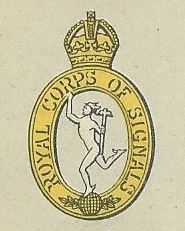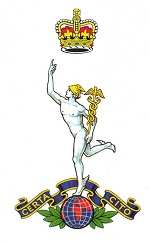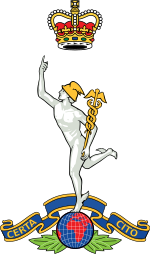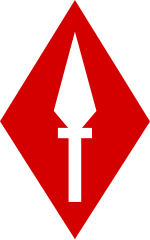
The Middlesex Yeomanry was a volunteer cavalry regiment of the British Army originally raised in 1797. It saw mounted and dismounted action in the Second Boer War and in the First World War at Gallipoli, Salonika and in Palestine, where one of its officers won a Victoria Cross at the Battle of Buqqar Ridge and the regiment rode into Damascus with 'Lawrence of Arabia'. Between the world wars the regiment was converted to the signals role and it provided communications for armoured formations in the Second World War, including service in minor operations in Iraq, Palestine, Syria and Iran, as well as the Western Desert, Italian and North-West European campaigns. It continued in the postwar Territorial Army and its lineage is maintained today by 31 Signal Squadron, Royal Corps of Signals, which forms part of the Army Reserve.
London District Signals was a headquarters signal unit of the Royal Engineers (RE) and later Royal Corps of Signals in Britain's Territorial Army from 1908. It served with a corps headquarters at Gallipoli and on the Western Front during World War I, and later became an air defence signal unit during World War II. Its successor unit continues in the Army Reserve today.
The 1st Newcastle Engineer Volunteers, later Northumbrian Divisional Engineers, was a Royal Engineer (RE) unit of Britain's Volunteer Force and Territorial Army founded in 1860. Its companies saw action in both World Wars, particularly at the Battle of Rosières and the assault crossing of the River Selle in 1918, and on D-Day in 1944. Its successors continue to serve in today's Army Reserve.
The North Midland Divisional Engineers was a Territorial Force unit of the British Royal Engineers created in 1908 by conversion of a volunteer infantry battalion from Staffordshire. It saw action in World War I at the Hohenzollern Redoubt, Gommecourt, Ypres, Cambrai, the German spring offensive and the Hundred Days Offensive, culminating in the assault crossings of the St Quentin Canal, the Selle and the Sambre. During World War II its component units saw action in the Battle of France, in Greece, Tunisia, Italy, Normandy and the Rhine crossing.
The 1st Lancashire Engineer Volunteer Corps was a Volunteer unit of Britain's Royal Engineers, first raised in 1860. It went on to spin off a unit of fortress engineers and provided a signals training centre during the First World War. Its successor units provided signal support for West Lancashire Territorial Army (TA) formations in the early stages of the Second World War, and for Eighth Army HQ during the Second Battle of El Alamein, the advance to Tunis, invasion of Sicily and through Italy, ending the war in Austria. Postwar successor units have continued in the TA and Army Reserve to the present day.
3rd Anti-Aircraft Brigade was a Supplementary Reserve air defence formation of the British Army formed in Northern Ireland in 1938. On the outbreak of the Second World War it saw active service with the British Expeditionary Force during the Battle of France and Operation Aerial. It then returned to Northern Ireland and defended the Province for the next two years. Postwar, it was reformed in the Territorial Army and served until the disbandment of Anti-Aircraft Command in 1955.

1st Armoured Division Signals was a unit of Britain's Royal Corps of Signals providing communications for the 1st Armoured Division during the Second World War. It was present during the Battle of France, the Western Desert Campaign, including the battles of Gazala and Alamein, the Tunisian Campaign, and the Battle of Coriano during the Italian Campaign.

The East Lancashire Royal Engineers was a Volunteer unit of Britain's Royal Engineers raised in Manchester in 1901. It became the engineer component of the 42nd Division of the Territorial Force, seeing service in Egypt, at Gallipoli and on the Western Front during the First World War. In the Second World War, it took part in the Dunkirk evacuation with 42nd Division, and then converted to the armoured assault engineer role in 79th Armoured Division in North West Europe. Its duplicate unit served in Tunisia and Italy. The unit continues today as part of 75 Engineer Regiment in the Army Reserve.

42 Signal Regiment was a Territorial Army unit of the British Army's Royal Corps of Signals. It had its origins in a Volunteer unit of the Royal Engineers formed in Manchester during the Second Boer War. It provided the divisional signals during both world wars, and served with the 42nd Division, the 66th Division, and the 66th Infantry Division. Its successor continues in the Army Reserve as a Signal Troop in Manchester.

The 1st Sussex Engineers was a Volunteer unit of Britain's Royal Engineers raised in Eastbourne in 1890. It became the engineer component of the 44th Division of the Territorial Force, but its units saw action with Regular Army formations on the Western Front, at Salonika and in Italy during the First World War, and in North Russia and Turkey after the war ended. During the Second World War, its units were in the Battle of France and at Alamein, in Sicily, on D Day and the subsequent campaign in North West Europe, including the Rhine crossing. Detached companies fought in Tunisia, Italy, and Burma, where one was involved in the decisive Battle of Kohima and the assault crossing of the Irrawaddy. The unit continued in the postwar Territorial Army until 1967.

44 Signal Regiment was a Territorial Army (TA) unit of the British Army's Royal Corps of Signals. It had its origins in a Volunteer unit of the Royal Engineers (RE) formed in the 1890s. It provided the divisional signals for the 44th Division and its duplicates in both World Wars, also seeing active service with 28th Division in the First World War. Its successor continued in the postwar TA and Army Reserve.

58 Field Squadron is currently an Explosive Ordnance Disposal (EOD) unit of the Royal Engineers (RE). In its long history its predecessors have fulfilled the roles of artisans, field engineers, chemical warfare specialists, and road builders. They saw active service on the Western Front in World War I and in the Battle of France and Burma Campaign during World War II. On two occasions, the unit's sappers were reputed to have repulsed enemy attacks at the point of the bayonet.

I Corps Troops, Royal Engineers was a battalion-sized unit of Royal Engineers (RE) attached to the British I Corps Headquarters in World War II. It served with the British Expeditionary Force in the Battle of France and Dunkirk evacuation, and later with 21st Army Group during the campaign in North West Europe 1944–45 from D Day until the German surrender at Lüneburg Heath. It later served in British Army of the Rhine.

II Corps Troops, Royal Engineers was a battalion-sized unit of Royal Engineers (RE) attached to the British II Corps Headquarters in World War II. It served with the British Expeditionary Force in the Battle of France and Dunkirk evacuation, and later in Home Defence until disbandment in 1943.

50 (Northumbrian) Signal Regiment was a Territorial Army (TA) unit of the British Army's Royal Corps of Signals. It had its origins in a signal company and a cyclist battalion formed in 1908 and it provided the divisional signals for the 50th (Northumbrian) Division and its duplicates during World War II. Its successors continued in the postwar TA until 2009.

47 (London) Signal Regiment was a Territorial Army (TA) unit of the British Army's Royal Corps of Signals. It had its origins in an engineer company and a cyclist battalion of the former Territorial Force that were amalgamated in 1920. It provided corps signal units during and after World War II. Following a series of postwar mergers Its successors continue in the Army Reserve today.

The City of London Signals was a Territorial Army unit of the British Army's Royal Corps of Signals. It had its origins in a signal company of the Royal Engineers formed in 1908 and during World War II it provided the divisional signals for the 56th (London) Division and its duplicates as well as communications for the Royal Air Force in the Middle East. Its successors continued in the postwar Territorial Army and Army Reserve until 2016.

43 (Wessex) Signal Regiment was a Territorial Army (TA) unit of the British Army's Royal Corps of Signals from 1920. It had its origins in a Volunteer unit of the Royal Engineers formed in the West Country in 1860 and provided the communications for the 43rd (Wessex) Infantry Division during World War II. Its successor still serves as a squadron in today's Army Reserve.

The Bristol Engineer Volunteer Corps was a part-time unit of Britain's Royal Engineers, first raised in 1861. It went on to provide the Sappers for the 48th Division of the Territorial Force, serving in both World Wars and postwar until 1967.

48 Signal Regiment was a Territorial Army (TA) unit of the British Army's Royal Corps of Signals from 1920. It had its origins in a Volunteer unit of the Royal Engineers formed in 1861 and provided the communications for several infantry divisions during World War II. Postwar it went through a number of reorganisations. Its successor still serves as a squadron in today's Army Reserve.









